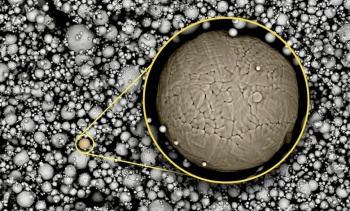
A team of researchers from Texas A&M University and the Air Force Research Laboratory (AFRL) has developed a technique for 3D printing defect-free parts made from martensitic steel, a steel variant with superior strength and which is more cost-effective to produce. The hard steel has applications in the aerospace, automotive and defense industries, among others.
“Strong and tough steels have tremendous applications but the strongest ones are usually expensive—the one exception being martensitic steels that are relatively inexpensive, costing less than a dollar per pound,” explained Ibrahim Karaman, Chevron Professor I and Head of the Department of Materials Science and Engineering at Texas A&M. “We have developed a framework so that 3D printing of these hard steels is possible into any desired geometry and the final object will be virtually defect-free.”
Unlike many types of steel alloy which are made from a combination or iron and other elements like carbon, martensitic steels are created by heating steels to an extremely high temperature and then cooling them rapidly. The cooling causes carbon atoms to become trapped within iron crystals, resulting in excellent strength. Using a laser-based AM process to produce parts from martensitic steels could enable more geometric freedom for martensitic steel applications.
Up until now, however, using a laser-based AM process with the hard steel powders has come with the risk of defects, including the creation of pores within the material. “Porosities are tiny holes that can sharply reduce the strength of the final 3D printed object, even if the raw material used for the 3D printing is very strong,” said Karaman. “To find practical applications for the new martensitic steel, we needed to go back to the drawing board and investigate which laser settings could prevent these defects.”

In its work, the Texas A&M team used an existing mathematical model used in welding to predict the melting pattern of a single layer of martensitic steel powder using various laser speed and power parameters. The team then analyzed the number of defects as well as the nature of the defects in these models, and adapted settings to improve the outcomes and prediction capability.
This eventually led to the creation of a framework with the ability to correctly predict if a new untested set of laser settings would lead to defects in the printed steel. This innovative forecasting technique will reduce the turnaround times for evaluating and finding the suitable printing parameters for martensitic steels.
“Testing the entire range of laser setting possibilities to evaluate which ones may lead to defects is extremely time-consuming, and at times, even impractical,” elaborated Raiyan Seede, a graduate student in the College of Engineering and the primary author of the study. “By combining experiments and modeling, we were able to develop a simple, quick, step-by-step procedure that can be used to determine which setting would work best for 3D printing of martensitic steels.”
The guidelines for printing martensitic steels without any defects can reportedly also be applied to other metals. This versatility is owed to the fact that the framework developed by the research group can be adapted to match the observations from single-track experiments for any type of metal powder.
“Although we started with a focus on 3D printing of martensitic steels, we have since created a more universal printing pipeline,” Karaman added. “Also, our guidelines simplify the art of 3D printing metals so that the final product is without porosities, which is an important development for all type of metal additive manufacturing industries that make parts as simple as screws to more complex ones like landing gears, gearboxes or turbines.”
The research project, which is supported by the Army Research Office and the AFRL, was published in the December issue of Acta Materialia.


